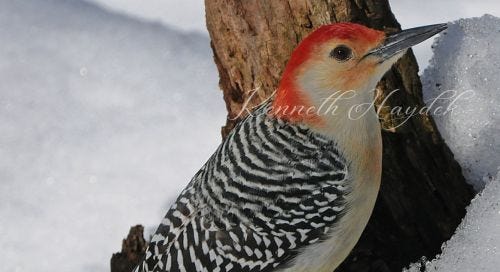What's black and white and red all over?
If you were thinking "a sunburned zebra," maybe guess again ...
November: The Red-Bellied Woodpecker
No, it’s not a typo. Yes, this bird really is called “red-bellied.” And while its back and wing feathers are fairly zebra-like in appearance, the red-bellied woodpecker certainly is not a sunburned zebra nor is it a red-headed woodpecker, even though the red-bellied woodpecker does indeed have a red head (but not so much a red belly). Confused yet? Let’s clarify some things about the red-bellied woodpecker....
To look at a red-bellied woodpecker, the most distinctive feature is by far its bright cherry-red head. On males, this red extends from the top of its crown, down the nape of its neck. On females, this red is only on its nape, leaving the crown the same buffy-white as its cheeks and breast. (Notably, there are red-headed woodpeckers, whose heads are entirely red, including their cheeks; whereas the red-bellied woodpecker has pale cheeks and throat.)
This bird is about nine inches in length (smaller than our friend from last year, the pileated woodpecker), with black-and-white barred feathers on its back and wings. White patches on its wingtips are visible when it flies.
Finally, only perceptible at certain angles, is its red belly, which appears more as a gentle rose wash or blush of rouge, in contrast to its bright bold head. Perhaps the name “red-belly” is a nod to the keen birder, as a little reward for noticing the least conspicuous aspect of this bird.
Red-bellied woodpeckers are permanent residents of the eastern portion of the United States. At one time, these birds were mostly in the southeastern states but have been expanding their presence northward, even to southern Ontario. They tend to congregate in low altitudes and river bottoms but seem to be largely adaptable to many environments, including mixed woodlands and tree-filled suburbs.
Woodpeckers in general have a reputation for making their presence known, and these woodpeckers are no exception. Their call is distinctive—and loud—so if the red-head makes you question if you’ve identified it properly, its unabashed vocalizations may guide you to the right field ID. Red-bellieds often tap with their beaks on metal gutters and pipes, successfully making themselves heard. What is more, males will tap on surfaces to attract females during mating season. If a female taps back, it means there’s a match!
Red-bellied woodpeckers are seasonally monogamous (but possibly will pair up again), and may have one to three broods during that season. Males begin the work of excavating a nest cavity in dead tree limbs, and may even start several nests, with the females having the final choice of location and chipping in as the hole nears completion. Both males and females incubate their clutch, and both feed their nestlings.
Red-bellied woodpeckers have long barbed tongues, which can extend close to two inches beyond the end of their beaks (!), and sticky saliva, features which provide them with a great advantage for getting food out of tree bark crevices. Red-bellieds are not picky eaters. They will eat insects, spiders, nestlings of other birds, lizards, tree frogs, minnows, seeds of all kinds, pine cones, acorns, and small fruits. In fall and winter months, red-bellied woodpeckers stash seeds and nuts deep in tree bark crevices where other animals can’t reach.
Red-bellied woodpeckers will also come around to feeders, providing onlookers with colorful undulating flight displays. In winter, red-bellieds are often attracted by suet cakes; they have also been known to enjoy the pulp and juice from orange and mango slices. So, if you live east of the Mississippi River, you just may be delighted by these ruddy splashes of color, especially if they are attracted to your area by an enticing variety of food.
Sources:
https://www.allaboutbirds.org/guide/Red-bellied_Woodpecker/overview
https://www.audubon.org/field-guide/bird/red-bellied-woodpecker
https://abcbirds.org/bird/red-bellied-woodpecker/
https://ebird.org/species/rebwoo
https://birdnote.org/podcasts/birdnote-daily/red-bellied-woodpecker-and-its-curious-name



